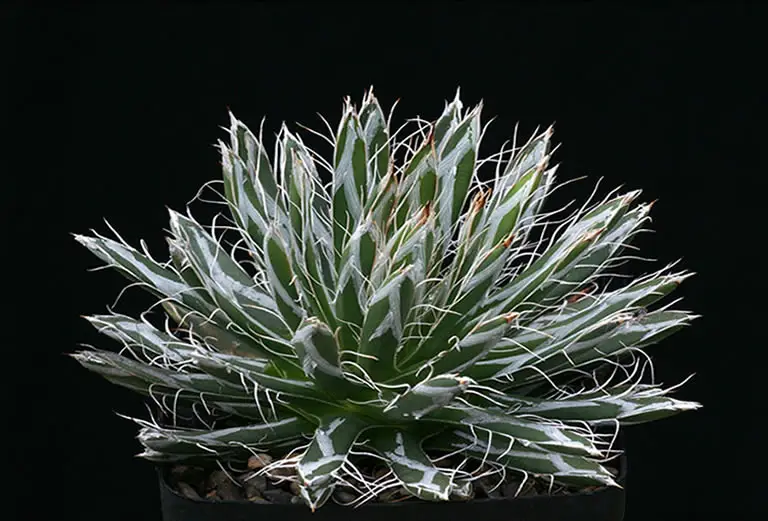If you’re after a houseplant that looks like a piece of modern art and practically thrives on neglect, the Agave plant is a dream come true. With its dramatic rosette of thick, spiky leaves, Agave brings a bold, architectural flair to any sunny corner of your home. But don’t let its tough exterior fool you—this desert dweller does have a few specific care needs if you want to keep it happy and thriving indoors.
Whether you’re new to Agave or just curious about its quirks, this guide will walk you through everything you need to know.
Table of Contents
- Where Agave Comes From: A Desert Darling with Ancient Roots
- Popular Agave Varieties for Indoor Growing
- Lighting Needs: Bright Light Is Non-Negotiable
- The Right Soil: Drainage Is Everything
- Watering: Think Infrequent but Thorough
- Temperature and Humidity: Hot and Dry Wins
- Growing Agave Outdoors: Sunshine, Space, and Smart Placement
- Fertilizer Needs: Keep It Light
- Repotting: Rare But Important
- Pruning and Grooming
- Propagation: Let the Pups Grow
- Common Issues and How to Avoid Them
- Fun Fact: Agave’s Flowering Drama
- Is Agave Toxic?
Where Agave Comes From: A Desert Darling with Ancient Roots
Agave has been around for thousands of years and hails from hot, dry regions of the Americas—especially Mexico and the southwestern United States.
These plants have adapted to thrive in tough environments with minimal rainfall and extreme sun, which makes them low-maintenance champs in a home setting.
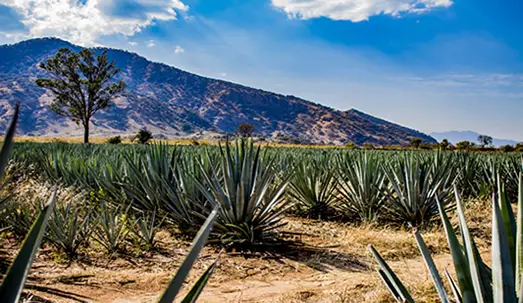
Beyond being easy on the eyes, Agave plants have played a significant role in indigenous cultures for centuries.
They’ve been used for everything from food and fiber to—you guessed it—tequila.
But not all Agaves are destined for cocktails!
Some are compact and well-suited for indoor living.
Popular Agave Varieties for Indoor Growing
While many Agave species grow huge in the wild (think 6-foot leaves!), there are some smaller varieties that are perfect for pots and indoor containers.
Here are a few houseplant favorites:
Agave parviflora (Small Flower Agave): Compact and slow-growing, with creamy leaf markings and fine white hairs.
Agave victoriae-reginae (Queen Victoria Agave): A stunning small variety with dark green leaves and striking white markings.
Agave potatorum (Butterfly Agave): Named for its wing-like leaf shape, it forms a beautiful symmetrical rosette.
Agave attenuata (Foxtail Agave): Known for its soft, curved leaves—this one lacks the typical Agave spikes, making it friendlier for high-traffic areas.
Lighting Needs: Bright Light Is Non-Negotiable
Agave is a sun-lover through and through.
To mimic its natural habitat, place it in the brightest spot you’ve got—ideally a south- or west-facing window.
It’ll tolerate some direct sunlight and actually prefers it.
If your home is more on the dim side, Agave will struggle, getting leggy or pale.
If you’re growing your Agave outdoors during summer, acclimate it slowly to full sun to avoid leaf burn.
The Right Soil: Drainage Is Everything
Agaves hate soggy roots. To keep yours healthy, plant it in a gritty, well-draining soil mix.
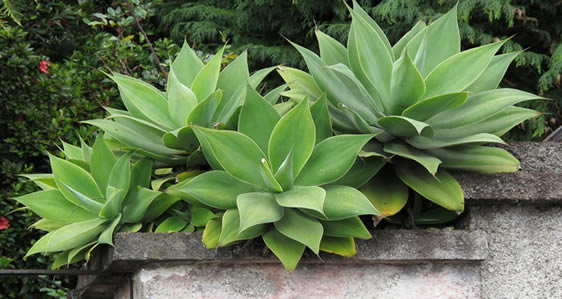
Cactus or succulent potting mixes are perfect straight from the bag, but if you’re a DIY type, you can make your own blend:
- 50% regular potting soil
- 25% coarse sand or perlite
- 25% pumice or fine gravel
Avoid using moisture-retentive soils or containers without drainage holes—they’re basically a death sentence for your Agave.
Watering: Think Infrequent but Thorough
This is where most people overdo it.
Agave stores water in its fleshy leaves and prefers to dry out almost completely between waterings.
A good rule of thumb: water only when the soil is bone dry, and then water deeply until it drains from the bottom.
In spring and summer, you might water every two to three weeks depending on your environment.
In fall and winter, once a month or less is usually enough.
Bonus tip: use the “pick-up test.” If the pot feels unusually light, it’s time to water.
Temperature and Humidity: Hot and Dry Wins
Agave thrives in warm, dry conditions, just like it would in the desert. Ideal temps are between 65°F and 85°F.
It can tolerate cooler temps down to 50°F, but anything colder and your plant might go into shock or start to rot.
Humidity isn’t a concern at all—this plant prefers dry air.
In fact, if you’re someone who constantly struggles with low indoor humidity, Agave will be one of your best plant friends.
Growing Agave Outdoors: Sunshine, Space, and Smart Placement
If you live in a warm, dry climate—or just want to give your indoor Agave a summer vacation—this plant can absolutely thrive outdoors.
In fact, many Agave species were made for the outdoors, where they can really show off their bold shapes and architectural presence.
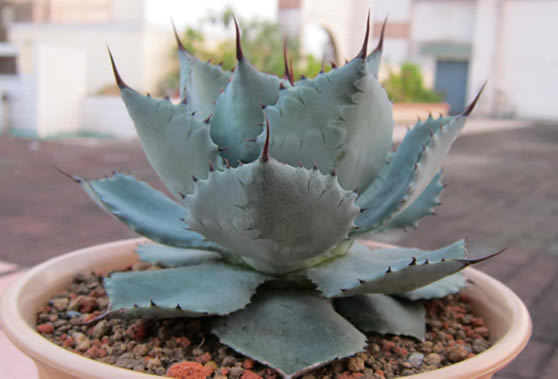
Here’s what to keep in mind if you’re planting Agave in your garden or moving your potted plant outside:
Climate Counts: Most Agave varieties prefer USDA zones 8 through 11. If your winters dip below freezing, choose cold-hardy species (like Agave parryi or Agave havardiana) or keep your Agave in a pot you can bring indoors before frost.
Sunlight Needs: Outdoor Agaves love full sun—but if you’re transitioning one from inside, acclimate it slowly to avoid sunburn. Start with a few hours of morning light and gradually increase its sun exposure over a week or two.
Soil Prep: Choose a location with excellent drainage. Sandy or rocky soil works best. If your native soil is heavy clay, amend it with sand, gravel, or pumice to keep things dry at the roots.
Spacing: These plants can get surprisingly wide over time, so give them plenty of space—at least 2 to 3 feet between plants, more for larger varieties.
Watering: Just like indoors, Agave grown outdoors doesn’t need much water. Deeply soak the soil once every few weeks during dry spells. Established plants can often go even longer.
Watch the Tips: Many outdoor Agaves have sharp, pointed leaf tips—some even have little hooks. Avoid planting them where people or pets might brush against them. Some gardeners snip the sharp tip to dull it (though this can slightly alter the plant’s natural look).
Bonus tip: if you’re planting in pots on a patio or balcony, terracotta containers are a great choice—they dry out quickly and add a natural, sun-baked aesthetic that pairs perfectly with Agave.
Fertilizer Needs: Keep It Light
Agaves aren’t heavy feeders. A light touch with fertilizer goes a long way.
In spring and early summer, you can feed your plant with a diluted succulent or cactus fertilizer (half-strength) once a month.
A good cactus fertilizer, like this one, works extremely well with agave plants.
Stop fertilizing in late summer so the plant can prepare for its dormant season.
Too much fertilizer can lead to weak, leggy growth or even root damage, so less is definitely more here.
Repotting: Rare But Important
Agaves are slow growers and don’t need frequent repotting.
You’ll know it’s time when you see roots growing out of the drainage holes or the plant becomes top-heavy.
When repotting, choose a container just one size up and refresh the soil mix.
Wear gloves when handling spiky varieties, and watch those sharp leaf tips—they’re no joke!
Pruning and Grooming
Pruning isn’t necessary unless you’re removing dead or damaged leaves.
Use sterilized scissors or garden shears, and snip leaves as close to the base as possible.
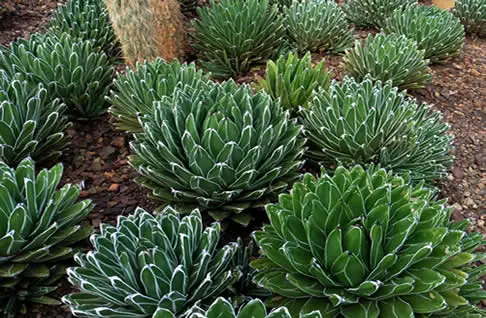
If dust builds up on the leaves, a gentle wipe with a damp cloth will keep your Agave looking sleek and help it absorb light more effectively.
Propagation: Let the Pups Grow
Agave rarely flowers indoors, and when it does, the mother plant will die after blooming (hence the name “century plant,” though it blooms much sooner than a century!).
Luckily, Agaves reproduce by sending up offsets, or “pups,” around the base.
When they’re a few inches tall and have their own roots, you can gently separate them and pot them up individually. Spring is the best time to do this.
Common Issues and How to Avoid Them
Root Rot: Caused by overwatering or poor drainage. If you notice mushy roots or a foul smell, act fast—remove the plant, trim any rot, and replant in fresh dry soil.
Leaf Spots or Softness: Usually from too much moisture. Always let the soil dry completely before watering again.
Stretching (Etiolation): If your Agave starts growing tall and leggy, it’s not getting enough light.
Move it closer to a sunny window.
Fun Fact: Agave’s Flowering Drama
Agaves bloom only once in their lifetime—some after 10 years, others much sooner or later depending on the species.
When it does, it sends up a tall flowering spike (some over 20 feet tall in the wild!).
Indoors, it’s rare to see this, but if it happens, enjoy the show.
After blooming, the mother plant will die—but by then, she’ll usually have produced plenty of pups to carry on her legacy.
Is Agave Toxic?
Yes—Agave contains saponins and oxalates that can irritate the skin and be harmful if ingested by pets or people.
Always keep it out of reach and handle with care, especially varieties with spiny leaves.
Want a stylish, spiky plant that looks good and doesn’t demand much? Agave might just be your new favorite roommate.
Give it sunshine, the occasional drink, and a little love now and then, and it’ll reward you with sculptural beauty for years to come.
Let me know if you’d like an infographic version or want to create printable care cards for your blog or socials—I’d love to help!

